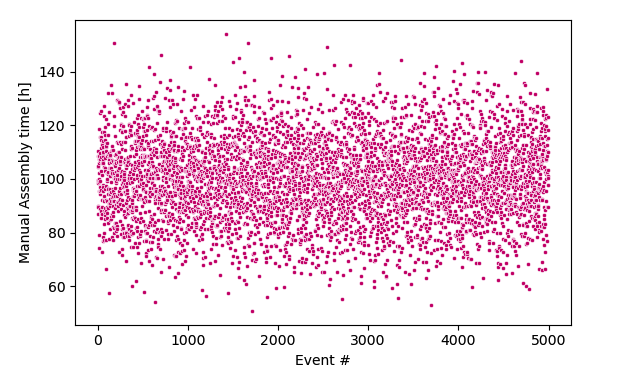Combining deterministic and non-deterministic processes
Discrete Event Simulation in Python

Diogo Costa (PhD, MSc)
Adjunct Professor, University of Saskatchewan, Canada & CEO of ImpactBLUE-Scientific
Deterministic and non-deterministic processes

Example: Management of passenger flow in airports
- Non-deterministic: Time a passenger arrives at the airport
- Deterministic: Transport of luggage inside the airport once checked-in
Example: Assembly line in a factory
Deterministic processes
- Transport of raw material to factory
- Fully automated steps
- Quality inspections
- Packaging
- Transport the new product to customers
Example: Welding machine
Processing time = Length of welding line x Speed of the welding machine
Non-deterministic processes
- Order of Raw Material
- Manual assembly of complex parts

Deterministic processes
Example: Assembly line with welding
2 deterministic processes
welding_1welding_2welding_1- Name of process: Welding component A
- Processing time:
5hours
welding_2- Name of process: Welding component B
- Processing time:
length * hours_per_length
Creating a dictionary for each process:
welding_1 = {
"name": "Welding component A",
"time_hours": 5
}
length = 20 # meters
hours_per_length = 0.2 # hours
welding_2 = {
"name": "Welding component B",
"time_hours": length * hours_per_length
}
Non-deterministic processes
Example: The assembly line
2 non-deterministic processes
manual_assembly_1manual_assembly_2manual_assembly_1- Name of process: Manual Assembly A
- Average processing time:
80hours - Standard deviation:
5hours
manual_assembly_2- Name of process: Manual Assembly B"
- Average processing time:
20hours
- Standard deviation:
2hours
Creating a dictionary for each process:
manual_assembly_1 = {
"name": "Manual Assembly A",
"time_hours": 80,
"std_hours": 5
}
manual_assembly_2 = {
"name": "Manual Assembly B",
"time_hours": 20,
"std_hours": 2}
Build an event-based simulation
Manufacturing sequence of processes

Discrete-event model
# Initiate time-tracking variable time = numpy.zeros(number_of_processes)# Next-event time progression time[0] = 0 time[1] = time[0] + welding_1["time_hours"] time[2] = time[1] + rd.gauss(manual_assembly_1["time_hours"], manual_assembly_1["std_hours"]) time[3] = time[2] + rd.gauss(manual_assembly_2["time_hours"], manual_assembly_2["std_hours"]) time[4] = time[3] + welding_2["time_hours"] time[5] = time[4]
Time units and exploring model
- Time units
- Ensure time units are consistent for all processes.
Let's practice!
Discrete Event Simulation in Python

